MARIANI’S
Virtual
Gourmet
February
22, 2015
NEWSLETTER
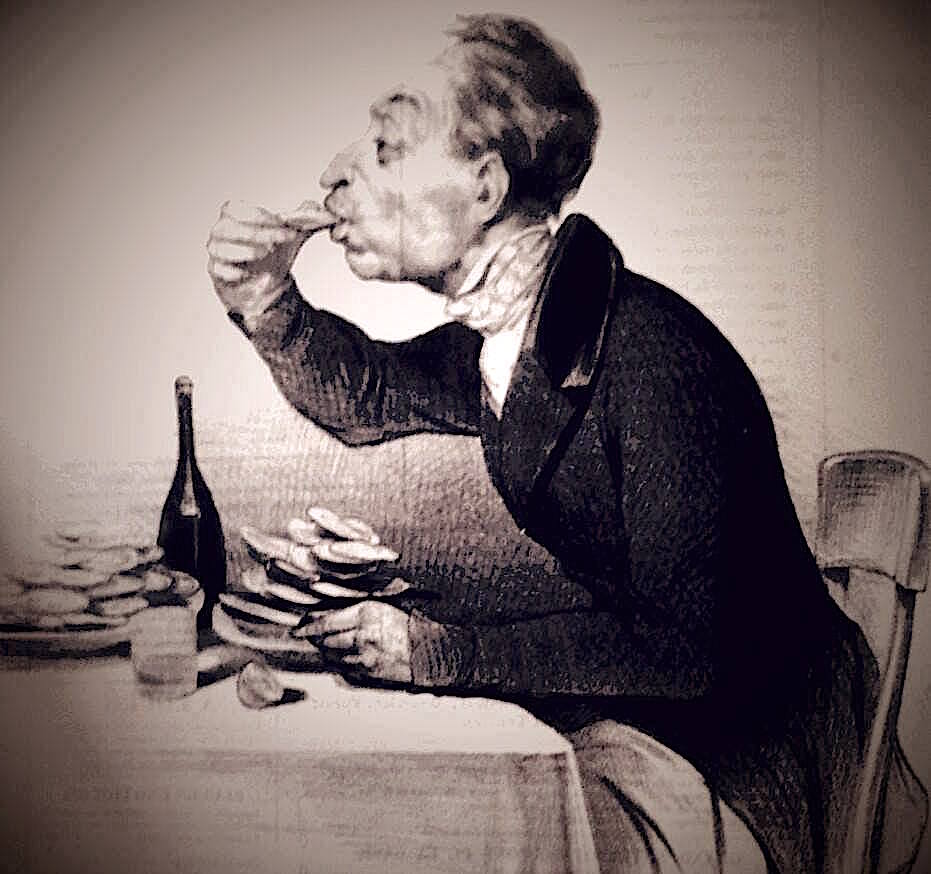
❖❖❖
IN THIS ISSUE
HIZZONER OPENS A STEAKHOUSE IN VEGAS
By John Curtas
NEW YORK CORNER
CULL AND PISTOL OYSTER BAR
By John Mariani
NOTES FROM THE WINE CELLAR
THE ROSÉS OF FRANCE'S SOUTH LAND
by Andrew Chalk
❖❖❖
HIZZONER OPENS
A STEAKHOUSE IN VEGAS
By John Curtas
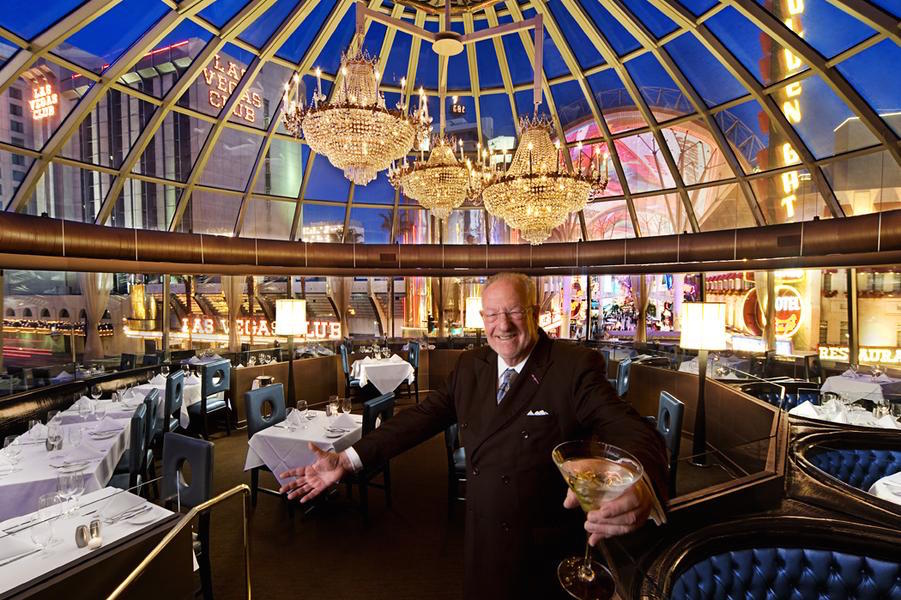
Oscar Goodman--the man, the
myth, the martini mob mayor--is not exactly my cup
of tea. It's not like we have ever had any sort of
feud. We’ve
never squared off in court, despite both being
practicing lawyers in Las Vegas for decades, and
we barely knew each other until he ran for mayor
in 1999. As a politician, he became obliged to get
to know everybody, and as a person who respects
thoughtful, human dignity, I was obliged to avoid
him and his ever-present martini glass as much as
possible.
When I first arrived in Las Vegas in 1981,
Goodman’s reputation as a mouthpiece for the mob was
already well established. As that career was winding
down, Goodman did not want to go quietly into that
good night, or feet first like many of his clients.
Had it not been for his desire to stay in the
spotlight in his later years, this highly visible criminal
lawyer would have retired with a legacy of getting
rich by representing a murderer’s row of model
citizens with names like “Fat Herbie,” “The Knife,”
“Ace,” “Lefty” and “The Ant.”
As various inconvenient circumstances
(prison, murder, witness protection) befell his
paying customers throughout the '80s and '90s,
Goodman saw the handwriting on the wall. But
exhibitionist/egomaniac that he is, he couldn't
resist another chance to be on stage, and thus was
his political career launched fifteen years ago. That
career, from 1999 to 2011, was audacious on many
levels. To say he had a blast as a three-term Mayor
of Las Vegas would be an understatement. To say he
got away with enough guffaws, gaffs and gasps to
sink a thousand political ships would also be overly
modest. No one saw him smoking crack in a hotel
room, or
running over people in
City Hall, but it's a fair bet that his
boozy, impolitic behavior---he told a fourth grade
class his hobby was drinking martinis--would have
had any other politician in America thrown out on
their ear.
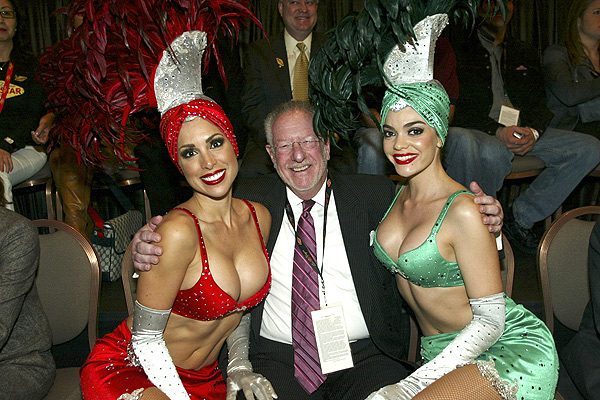 Not Oscar though.
Acting the clown just made him more popular, and
you’ve got to hand it to someone who can seduce a
landslide majority of
the people to vote for him, in three
consecutive elections. (Local law prevented him from
seeking a fourth term.) No doubt Oscar Goodman could
talk a tadpole out of a mud pond. What he can't do
is run a restaurant.
Not Oscar though.
Acting the clown just made him more popular, and
you’ve got to hand it to someone who can seduce a
landslide majority of
the people to vote for him, in three
consecutive elections. (Local law prevented him from
seeking a fourth term.) No doubt Oscar Goodman could
talk a tadpole out of a mud pond. What he can't do
is run a restaurant.
And he doesn't even try to. Whatever
licensing deal he has with The Plaza Hotel and
Casino has nothing to do with his culinary skills or
restaurant business acumen. He is unabashedly in it
for the ego, the money (which he doesn't need), and
one more chance to enhance his big-shot status. He
probably also enjoys eating and drinking for free,
and always getting a table with his name on it, but
take it from me, it doesn't take much in Vegas to
accomplish that.
When I first heard of
the gimmicky concept for Oscar's Beef
Booze & Broads three years ago, I was
less than impressed, and said so. My
meals there were, to be kind, underwhelming. About a
year and half ago, I stopped by for a quick bite and
noticed that the place had rounded into form--the
service smoother, the staff more professional, and
some dishes (especially the beef) were more
carefully cooked. Even with these improvements,
though, nothing about the place showed me that it
belonged on even the second tier of Vegas’s great
steakhouses.
Were it not
for the entreaties of executives at the hotel to
come check it out again (and give them my honest
opinion), I might never have given hizzoner, or his
steaks, a second thought for the rest of my life.
But as a favor to them, I went, ate and was
pleasantly surprised by some dishes, blown away by
others, and seriously disappointed by a few.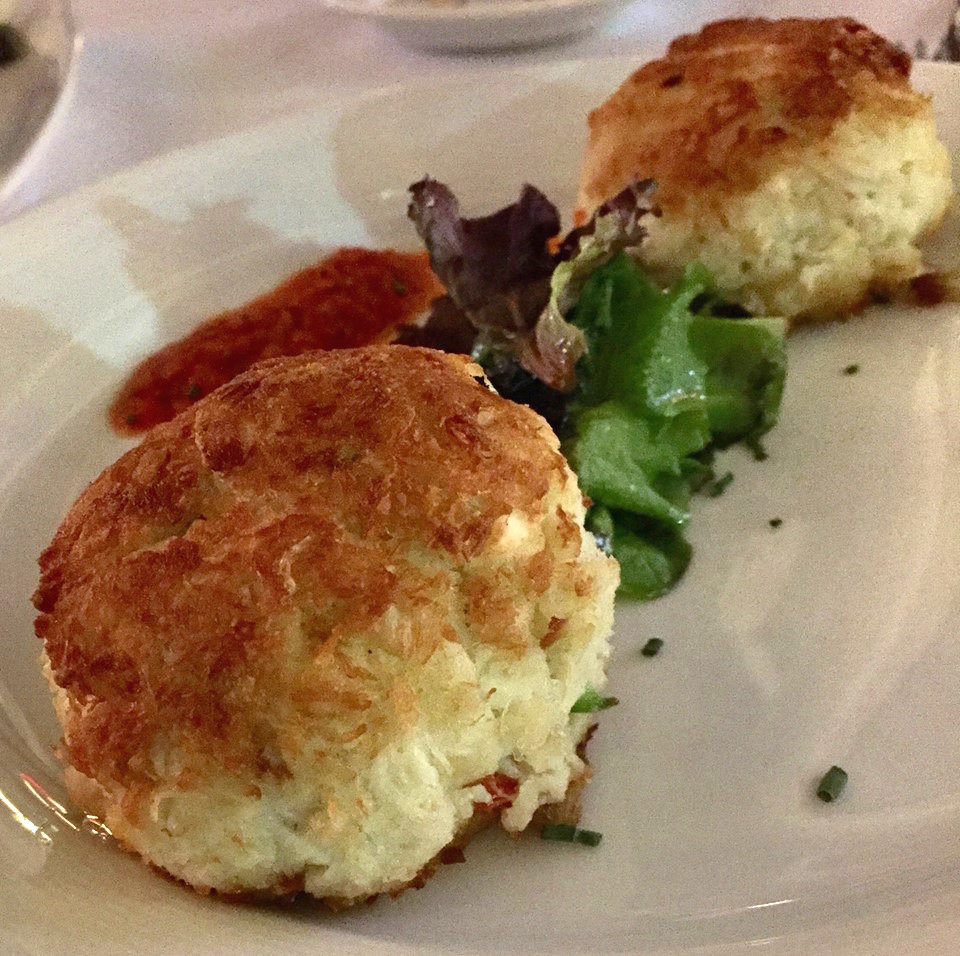
The strong points--the service, decor,
bar--have only gotten better, and some menu
weaknesses have been ironed out (the bread and
butter much improved). The meat may not be Japanese
A-5, but it is B+ to A- American steer, and they
know how to handle it on the grill. Where Oscar's
deserves demerits, though, is in the careless
execution of the lesser dishes, and for something
vague and inchoate that's missing from the formula:
It's a feeling, an emotional response to the food
that is strangely absent, and a room that evinces
more corporate calculation than nostalgia and charm.
A great steakhouse is equal parts attitude
and appetite. Steakhouse fare is iconic American
restaurant fare. We invented the steakhouse and
still do the best ones on Earth. If you want to see
what the early ones looked like, plan a pilgrimage
to Peter Luger's (est.1887)
in Brooklyn, where the 19th century beer hall
ambiance remains as untouched as a Grover Cleveland diet
book. The best ones are in New York City--where the
genre first took hold--and whether they are sleek
and new, or hallowed and ancient, they reek of beefy
masculinity so strong you could cut the testosterone
wafting about with a knife.
America's second best steakhouse town is Las Vegas.
The great ones have a swagger about them that is
palpable--sort of like a certain gin-loving ex-mayor
we know. In Oscar's case, as you can see, much of
the food is not oh and ah worthy. Take the crab
cakes (right).
They are perfectly fine, plump with more backfin
than lump meat, but lightly bound with a minimum of
filler. They sit somewhat forlornly on a big white
plate, flanked by two schmears of sauce that lack in
both volume and piquancy. There is nothing wrong
with these crab cakes, but they won't have anyone
leaving the joint saying, "Damn, I can't wait to
come back for those crab cakes."
The same could be said of the shrimp
cocktail--big and juicy and plenty shrimpy, but also
looking like they were thrown on the plate as an
afterthought.
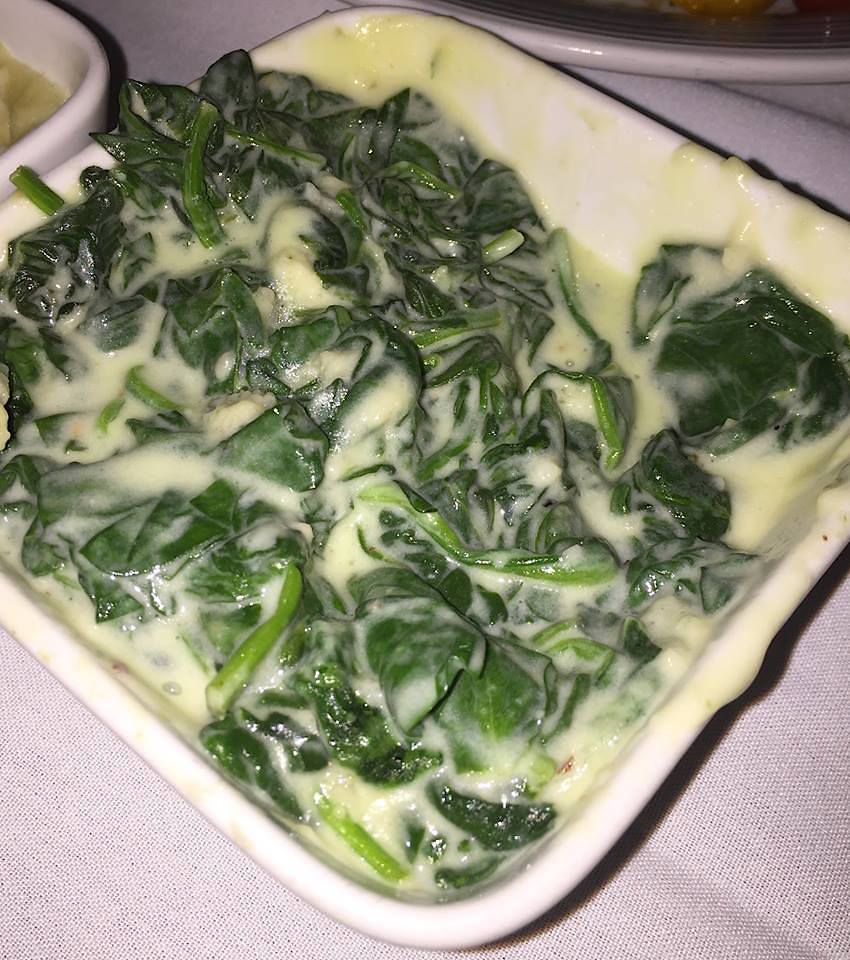 Truly
terrible
was the creamed spinach (left), looking and tasting like
barely wilted greens swimming in milk. The Caesar
salad looks right but tastes as if lemon, anchovy
and garlic had never made its acquaintance. It's not
a bad salad; it's just a bland salad.
Truly
terrible
was the creamed spinach (left), looking and tasting like
barely wilted greens swimming in milk. The Caesar
salad looks right but tastes as if lemon, anchovy
and garlic had never made its acquaintance. It's not
a bad salad; it's just a bland salad.
On the plus side, the Alpine Village Famous
Chicken Supreme Soup makes up in flavor what it
lacks in appearance. It also tastes exactly like the
original (if our 25-year-old taste memory serves).
All that's missing is the bathtub-sized bowl of raw
veggie crudités that used to be on every table at
the German restaurant on Paradise Road.
The mac n' cheese is a thick, gloppy, cheesy delight
(if you love such things), as were the au gratin
potatoes. And the veal chop is terrific, not the
quality of the one at Picasso,
but as good as you're going to find in town, for
about ten bucks less than is charged on the Strip.
That bone-in rib eye is no slouch either, and a
bargain compared with what you'll pay two miles to
the south. The same can be said of all steaks here.
They're so good that anyone who even thinks of
ordering fish or chicken should have their head
examined.
The wine list is short, but well chosen, with
plenty of bottles under $100; try finding that at the
Wynncore.
Just about the time those delicious cuts were
erasing all memories of the Caesar and 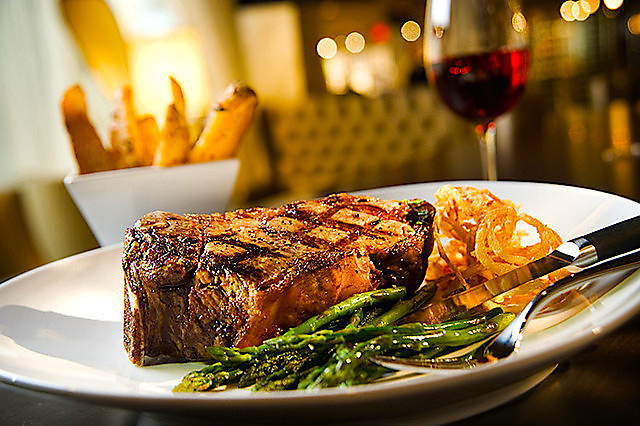 spinach, the desserts showed up and
laid an egg. There was an apple thing laden with
globs of cornstarch and a tiramisu thing that looked
like snowball cupcakes. I should’ve quit while I was
ahead.
spinach, the desserts showed up and
laid an egg. There was an apple thing laden with
globs of cornstarch and a tiramisu thing that looked
like snowball cupcakes. I should’ve quit while I was
ahead.
So-so vittles or not, Oscar--the man, the
restaurant, the boozy, spotlight hogging
politician--is clearly ahead of the game. The
popularity of all three incarnations remains high,
and even on slow weekday nights this place will
still be half full.
Patrons from all over the country book tables
in hopes of getting a glimpse of the Mob Lawyer
Mayor. Maybe some of his odd charisma will rub off
on them (they hope). Maybe Oscar’s will be a
once-in-a-lifetime, only-in-Vegas experience. Maybe
his steakhouse will be everything Goodman the man
is: outrageous, over-the-top and one-of-a-kind.
Instead, what they will
find are some very good steaks served amidst hits
and misses on the menu, in a room that ought to feel
like a stage set in the movie of Oscar Goodman’s
colorful life, instead of a fancified hotel dining
room with a domed ceiling at the foot of Fremont
Street.
And
when it comes down to it, that’s really the problem
with Oscar’s. For a steakhouse in a steakhouse town
named after a guy with chutzpah and personality, it
has none of one, and very little of the other.
Oh, the irony.
OSCAR'S BEEF BOOZE & BROADS
In The Plaza Hotel and Casino
1 Main Street
702-386-7227
oscarslv.com
By John Mariani
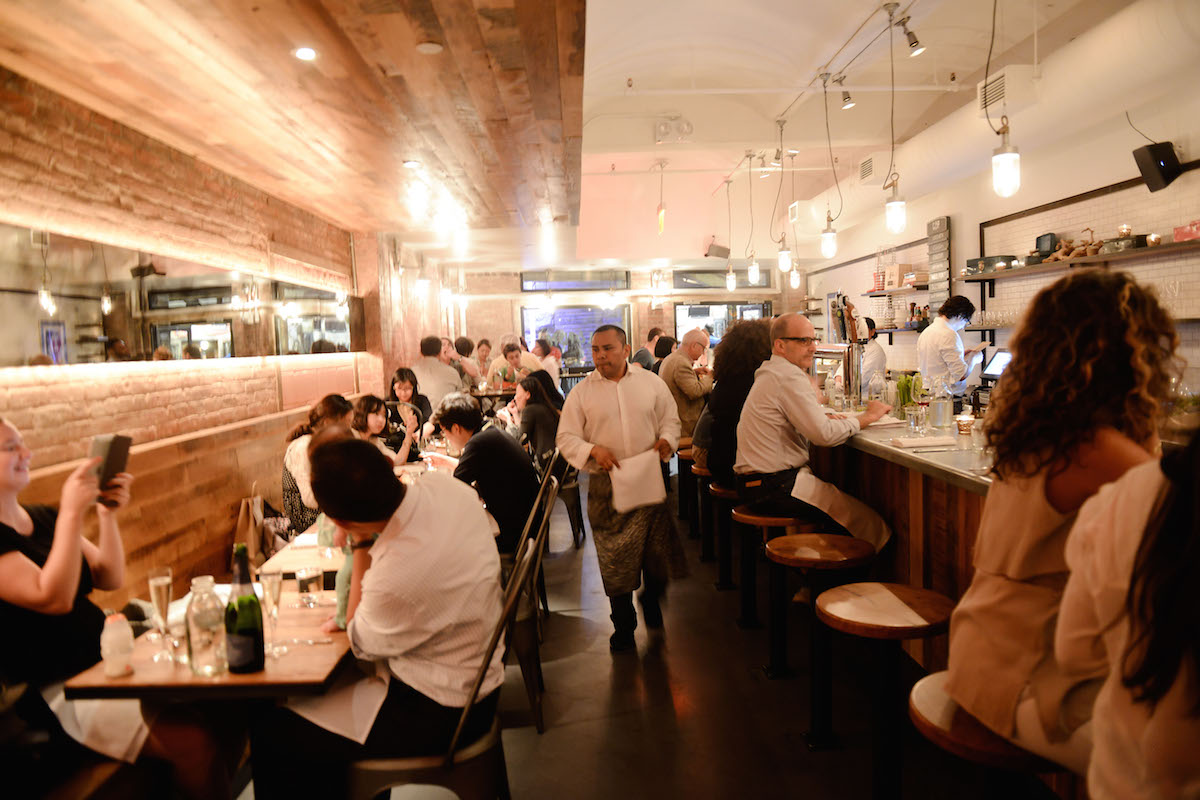 CULL
& PISTOL
CULL
& PISTOL OYSTER BAR
Chelsea Market
75 Ninth Avenue
646-568-1223
lobsterplace.com
The
diversity of restaurant styles in NYC never
ceases to amaze me. Once upon a time the
city’s ethnic restaurants fit into pretty
standard categories—haute cuisine classic
French, Italian-American, Sichuan and Hunan,
teppanyaki, and so on. But the variations on all
genres keep NYC first among American cities, as
this week review shows.
The maze of eateries in Chelsea Market
is like one of those “Laughter in the Dark” rides at
amusement parks where you turn a corner and are
surprised by what pops into view: Amy’s Bread, Bar
Suzette, Buddakhan, Doughnuttery, The Green Table,
l’Arte de Gelato, Morimoto, One Lucky Duck, and The
Lobster Place.
At this last, some of the city’s finest
seafood is sold, and attached to the market is Cull &
Pistol Oyster Bar, a slip of a seafood restaurant
where exec chef David Seigal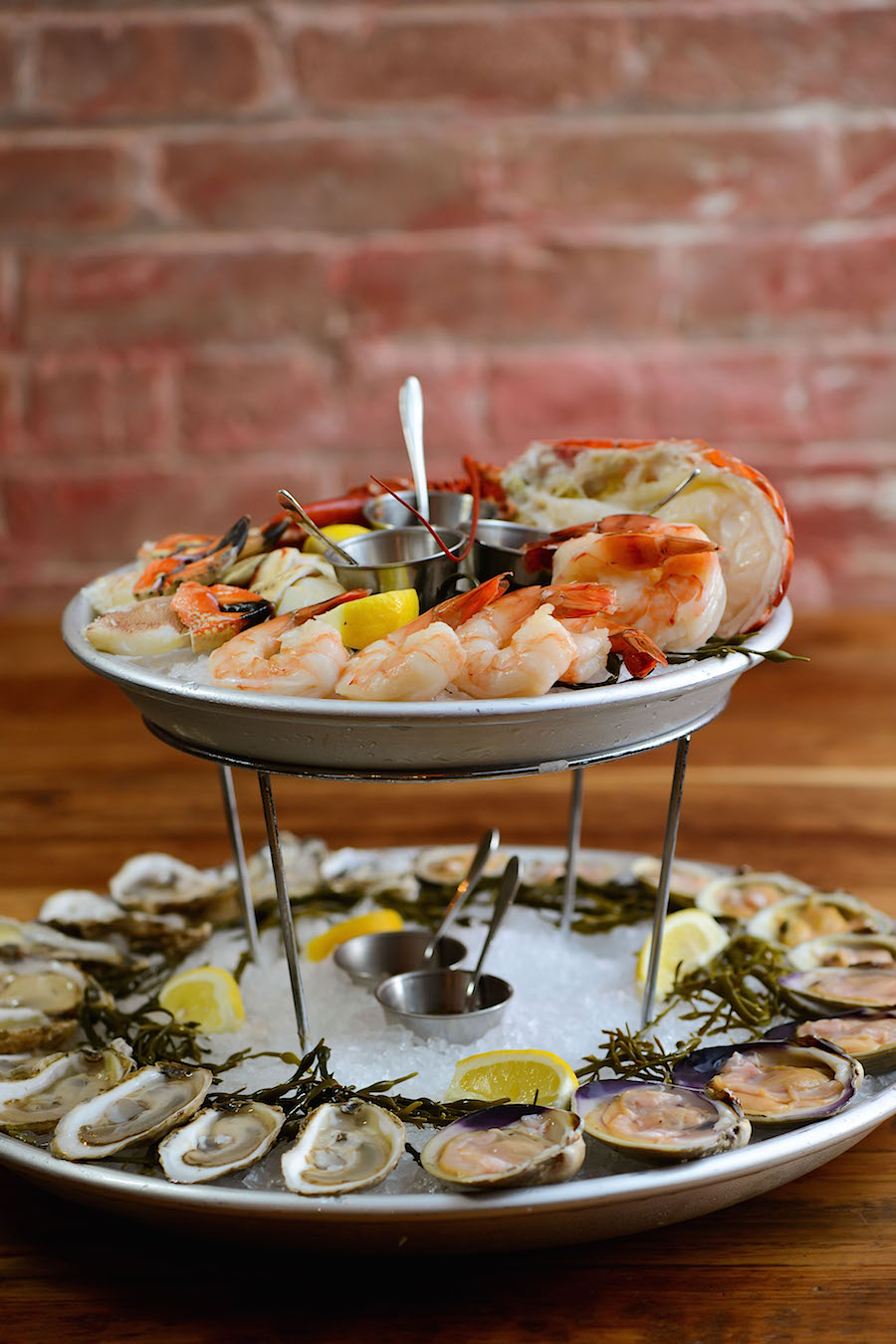 is going
way beyond the typical seafood menu.
is going
way beyond the typical seafood menu.
A cull is a lobster that has lost one of its claws,
a pistol one that’s lost both, and in addition to a
wide variety of oysters written on a blackboard (right), there
are some delightful lobster dishes like lobster pho ($19)
with vermicelli noodles, mussels, hake, chili, coriander, mint,
lime, and bean sprouts, as well as a fine
rendering of a Maine-style lobster roll (below) made with chilled lobster
salad with mayonnaise and scallions, or Connecticut
Style, warmed in lobster butter and lemon
with mayonnaise
toasted top split bun accompanied by excellent
French fries (market price).
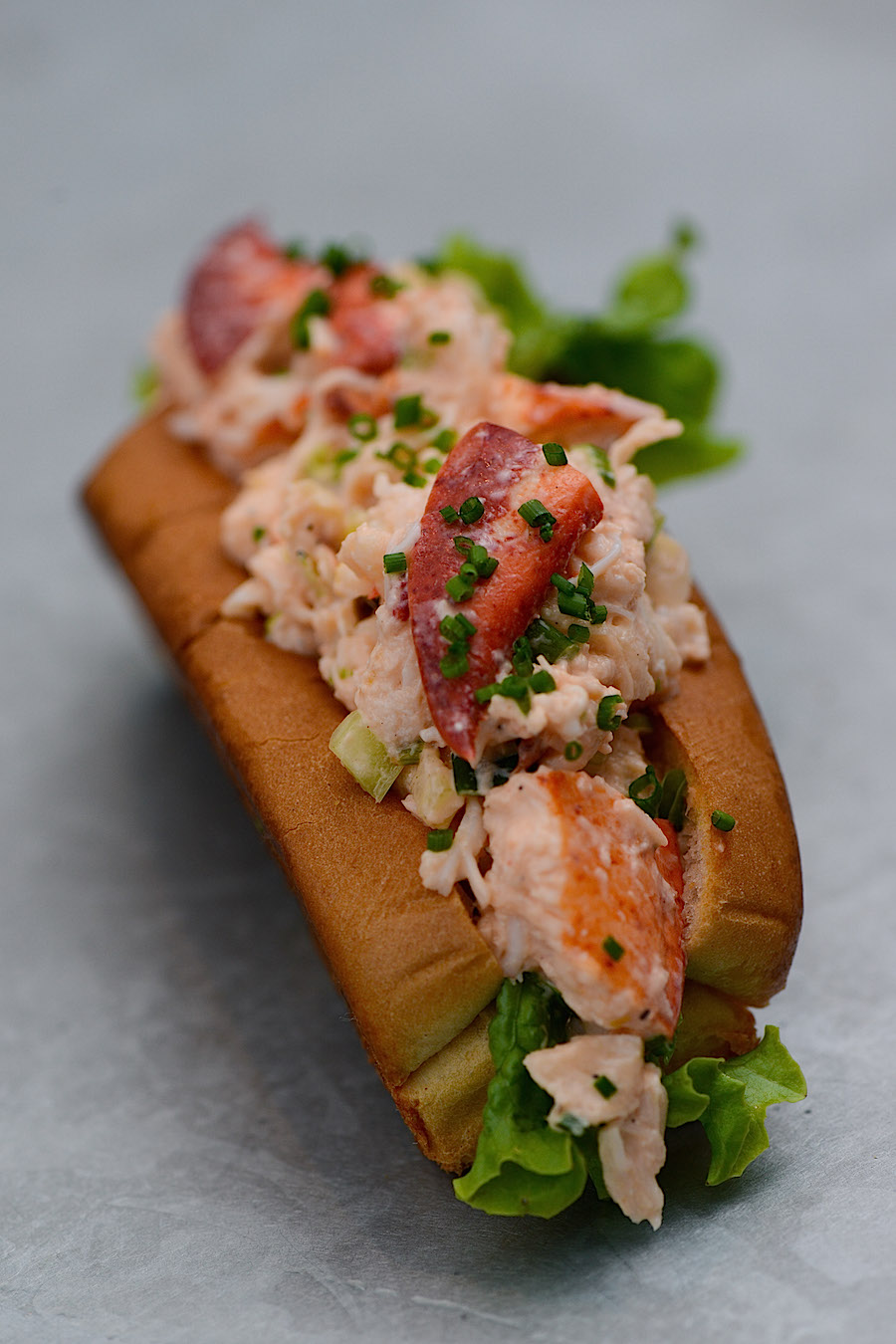 Seigal
grew up on the shores of Long Island, during college
worked on a fishing boat, and became an
accomplished sports fisherman. His culinary cred
comes from stints at Jean-Georges, Bouley, and
top-tier restaurants abroad before returning to NYC
to become chef at Mercat and now at Cull &
Pistol, where his menu changes daily, wholly
dependent on what’s fresh in the Lobster Palace next
door--which must be every chef’s dream. With this
cornucopia of raw product he creates dishes like
baby octopus braised in tomatoes with blue corn
grits, oregano and olives ($16) and one of the best
pasta dishes in NYC--bucatini carbonara with
sea
urchins, whitefish,
and bacon lardons
($15 to $21).
Everything just clicks into place.
Seigal
grew up on the shores of Long Island, during college
worked on a fishing boat, and became an
accomplished sports fisherman. His culinary cred
comes from stints at Jean-Georges, Bouley, and
top-tier restaurants abroad before returning to NYC
to become chef at Mercat and now at Cull &
Pistol, where his menu changes daily, wholly
dependent on what’s fresh in the Lobster Palace next
door--which must be every chef’s dream. With this
cornucopia of raw product he creates dishes like
baby octopus braised in tomatoes with blue corn
grits, oregano and olives ($16) and one of the best
pasta dishes in NYC--bucatini carbonara with
sea
urchins, whitefish,
and bacon lardons
($15 to $21).
Everything just clicks into place.
There is a nightly
salt-baked whole fish done simply with lemon,
thyme and garlic marinade ($27) and his
miso-glazed hamachi
collar with a mushroom dashi, scallions, honshimeji mushrooms, and yuzu koshu oil ($24) shows his global
reach. You can also have a Clambake Dinner for Two ($79),
teeming with a 1.5 lb lobster, mussels, shrimp,
chorizo, corn on the cob and fingerling potatoes,
served family style in a rich shellfish broth. 
The
premises are dominated by a long, very popular
metal-topped counter in front of a spanking
white tile wall. Here people slurp up
their Wellfleets, Apalachicolas, belons, and
other nightly species. Opposite is a brick wall
lined with tables and hanging light bulbs.
The waitstaff is extremely knowledgeable about
the night’s offerings, and the wine and beer
list is crafted to go with Seigal’s seasonings
and components, and most wines are under
$50. By comparison, the desserts like pear
galette
and a chocolate-peanut butter semifreddo
($9) are all right if nothing unique.
Cull & Pistol is always a happy place,
loud, as you might expect, but not
ear-splitting, and by being as small as it
is, the guarantee of freshness and creativity is
evident in every dish.
Open every day for
lunch and dinner.
❖❖❖
NOTES FROM THE WINE CELLAR
THE
ROSÉS OF FRANCE'S SOUTH LAND
By Andrew Chalk
Provence. The word conjures up
fields of lavender and sweeping hillsides of vines
set against craggy stone backdrops 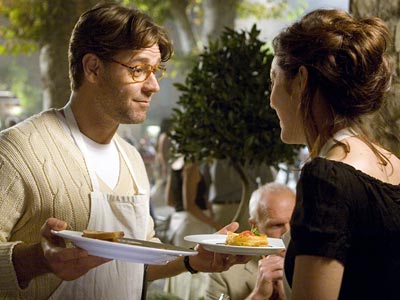 and mountains immortalized by Cézanne
and Picasso. Since the 1989 publication of Peter
Mayle’s classic A Year In
Provence and the movie version called "A Good
Year" (right)
the region has also stood for a certain bucolic
lifestyle set in a land of nature’s bounty.
and mountains immortalized by Cézanne
and Picasso. Since the 1989 publication of Peter
Mayle’s classic A Year In
Provence and the movie version called "A Good
Year" (right)
the region has also stood for a certain bucolic
lifestyle set in a land of nature’s bounty.
Part of that bounty is wine, and
the wine of Provence is rosé. Almost 90% of region's
production goes to produce the pink or salmon
colored beverage. Latching onto a global trend
toward more rosé consumption, Provence production
has grown at a steady 10% a year for the past decade
and Provence now accounts for 5% of world rosé
production. France is the largest market, where rosé
is now more popular than white wine, and the U.S. is
number two. Together, they account for just under
half of the region’s output. Among rosé producing
areas of the world, Provence is in the top
tier.
Perhaps it was
the growing popularity of Provence rosé that led
Brad Pitt and Angelina Jolie to purchase an estate
there and release its wine, Château Miraval, which received positive
expert reviews. While Hollywood
producer Scott Rudin may consider her “a minimally talented spoiled brat,” she
and Brad were hands off, leaving the winemaking to
one of France’s most respected winemakers, Famille Perrin.
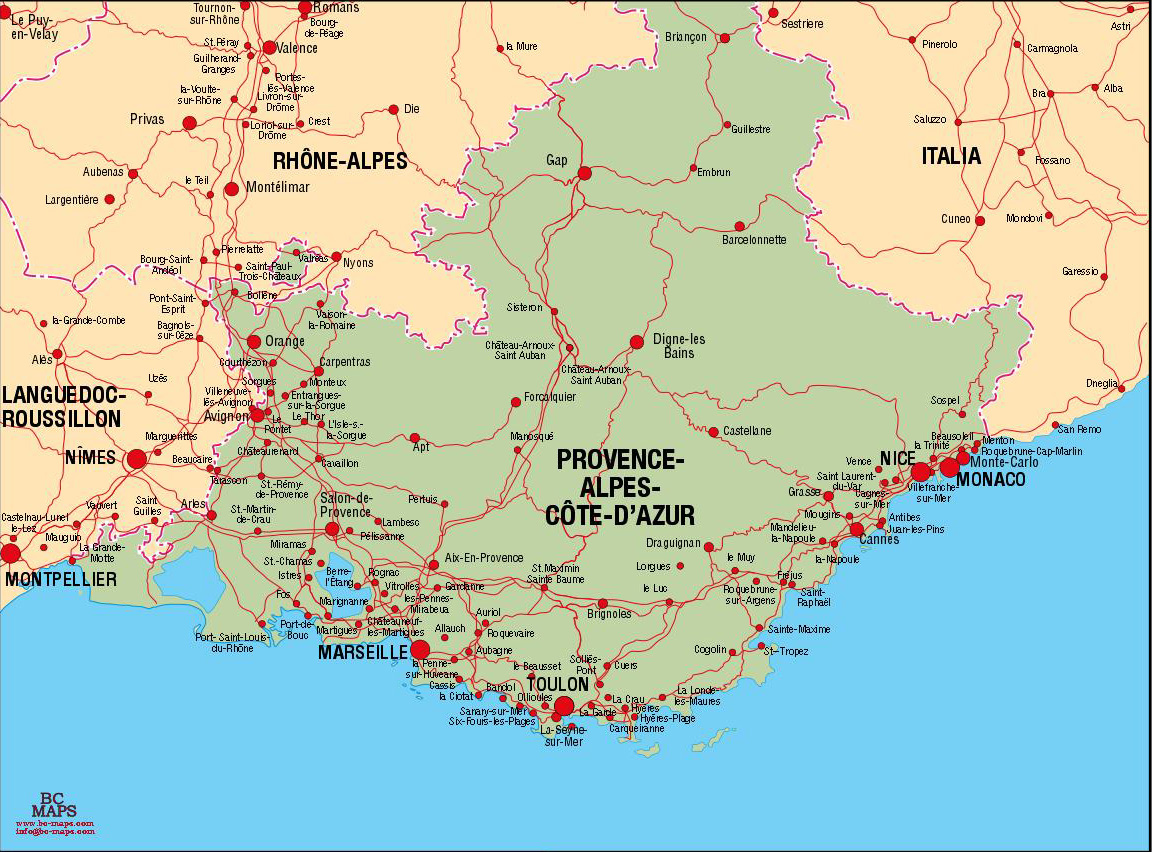 Provence is 100 miles
wide, stretching from Nice to Aix-en-Provence and
from the Alps to the Mediterranean sea. Both the
climate and the soil change as one moves around the
region. The French classify the best designated wine
regions as AOP (Appellation d’Originé Protégée). AOP
delimits an area of grape production, sets rules
regarding which grapes can be used, and sets
production standards, such as maximum permitted
yields. Beyond knowing the producer itself, it is
the consumer’s best guide to a wine’s quality. In
Provence there are three AOPs, reflecting three
distinct growing areas within the region. Côtes de
Provence (literally,
slopes/hills of Provence), Côteaux d’Aix-en-Provence
(hills of Aix-en-Provence) and Côteaux Varois en
Provence (hills of the Var in Provence). You will
see Côtes de Provence wines most of all as it
accounts for 72% of total AOP Provence
production.
Provence is 100 miles
wide, stretching from Nice to Aix-en-Provence and
from the Alps to the Mediterranean sea. Both the
climate and the soil change as one moves around the
region. The French classify the best designated wine
regions as AOP (Appellation d’Originé Protégée). AOP
delimits an area of grape production, sets rules
regarding which grapes can be used, and sets
production standards, such as maximum permitted
yields. Beyond knowing the producer itself, it is
the consumer’s best guide to a wine’s quality. In
Provence there are three AOPs, reflecting three
distinct growing areas within the region. Côtes de
Provence (literally,
slopes/hills of Provence), Côteaux d’Aix-en-Provence
(hills of Aix-en-Provence) and Côteaux Varois en
Provence (hills of the Var in Provence). You will
see Côtes de Provence wines most of all as it
accounts for 72% of total AOP Provence
production.
All of the rosé
wines are made from some blend of four key grapes:
Grenache, Cinsault, Mourvèdre and Tibouren.
Additionally, Syrah, Counoise and Cabernet Sauvignon
are sometimes used. The method of production is to
crush the grapes and let the juice macerate with the
skins just long enough for the color to turn pink.
At that point the juice is run off from the skins
into tanks to ferment into wine.
Fortunately, more and more of the best wines are
becoming available in this country. Here are some
that I can recommend. Most will be 2013 vintage,
with the 2014s appearing later in the year.
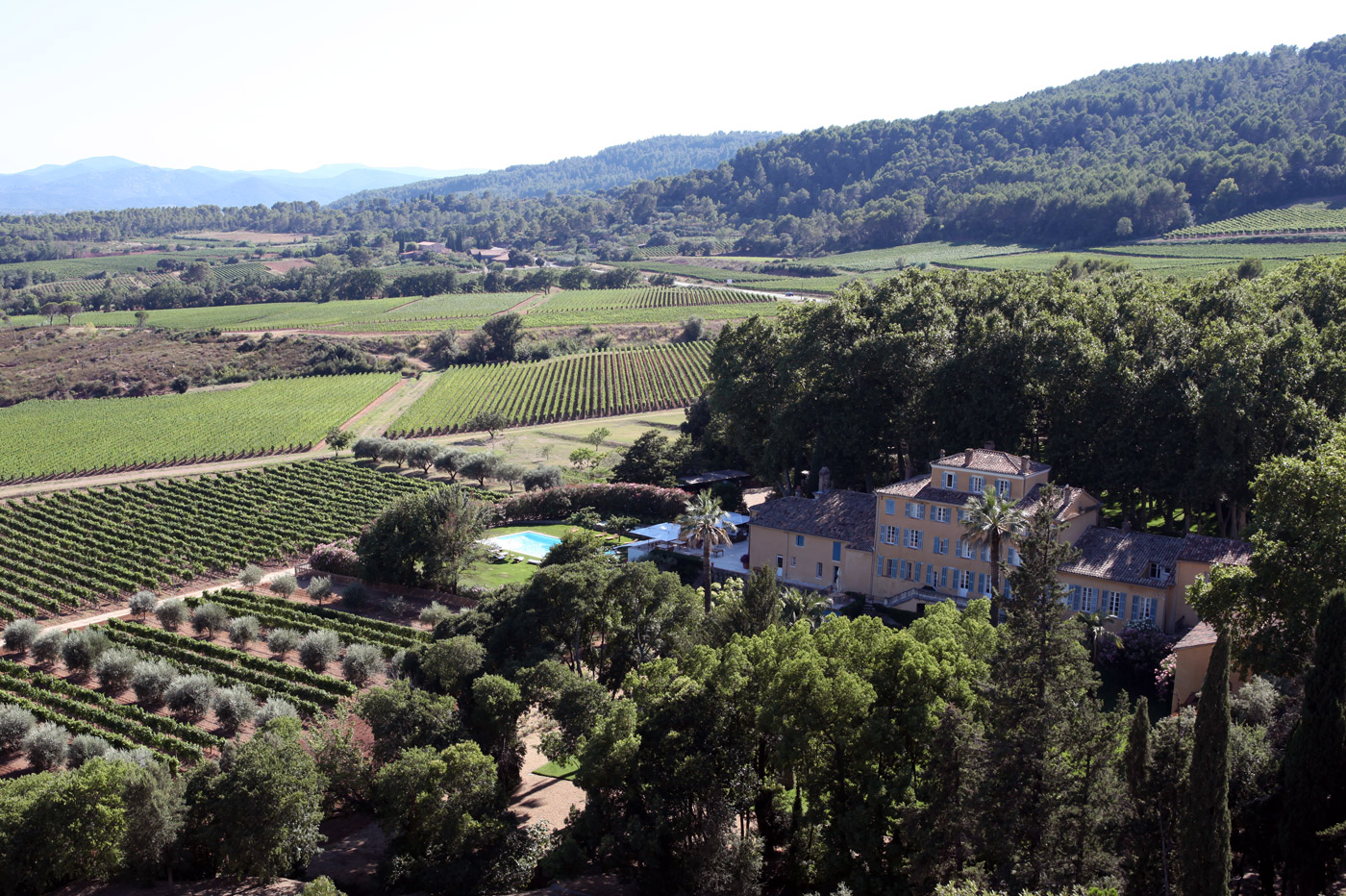
Caves d’Esclans, Les Clans, Côtes de Provence. $65
(left)
These
folks are extremely proud of their wine. Hence the
pricing at about three times everybody else. This is
an elegant wine. However, it is down to your palate
to decide whether it is worth it.
Domaine
Houchart, Côtes de Provence. $15 (below)
Bargain
example of Provence wine. Some Syrah and Cabernet
Sauvignon in the blend. The Cabernet Sauvignon give
this wine the grippy backbone associated with
Cabernet-based rosés. Fruity rather than
terroir-driven.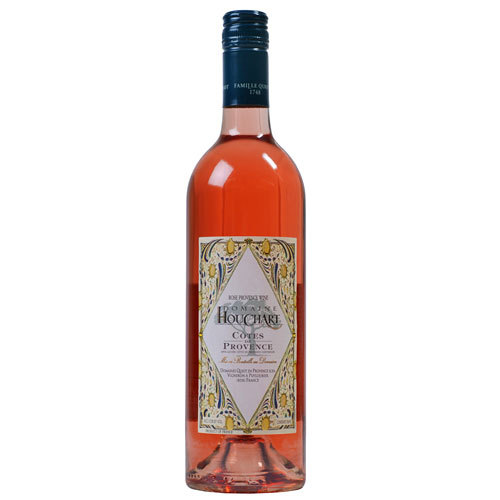
Mâites
Vignerons de la Vidaubanaise, Le Provencal, Côtes
de Provence. $15
Another
bargain. Made from 50% Grenache, 20% Cinsault, 20%
Carignan and 10% Syrah fermented separately for
maximum varietal fruit extraction. The bottle is the
traditional Provencal flute à corset.
This wine has a complexity beyond what its price
would lead you expect.
Château
de Berne, Terres de Berne, Côtes de Provence. $20.
Glorious
salmon color. Made from 50% Cinsault, 40% Grenache
and 10% Cabernet Sauvignon. The distinctive square
bottle belies a wine that scored 90/100 points in
The Wine Enthusiast. The pinkness of the color
differs from the wines above. Light, herbaceous nose
and raspberries in the mouth. Plus, more oomph than
the pale pink color would lead you to expect.

Domaine
de Rimauresq, Rimauresq, Côtes de Provence - Cru
Classé. $24.
Barely
tinted pink, this wine is a blend of all four core
varieties, plus Syrah, Cabernet Sauvignon, Carignan
and the white grape Rolle (the French name for
Vermentino). Light, with raspberry, melon and floral
notes. Chalky minerality.
Commanderie
de la Bargemone, Coteaux d’Aix-en-Provence. $19.
This
wine uses 6% white varieties (Sauvignon Blanc, Ugni
Blanc and Rolle) as well as the standard red grapes.
Robert Parker gave this wine 90/100 points, noting
its “pretty notes of mineral water, melon rind and
orange blossom . . . .” I would concur and add
reference to the limestone mineral backbone.
❖❖❖
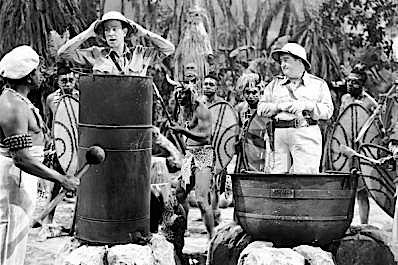 SORRY,
SIR, WE'RE ALL OUT OF CHEEK
SORRY,
SIR, WE'RE ALL OUT OF CHEEKA tip-off to police in Anambra, Nigeria, led to the discovery at the hotel restaurant of two human heads wrapped in cellophane AK-47 guns and other weapons were also seized. One local told the Osun Defender newspaper: "I always noticed funny movements in and out of the hotel; dirty people with dirty characters always come into the hotel." A local pastor said they sold human meat at the price of 700 Nigerian nairas (about US$3.56).
BLOCK
THOSE METAPHORS!
"The
building that houses Santina, the charismatic new
restaurant from the Torrisi crew, is a gleaming glass
box tucked under the High Line, like a festive sock
drawer for twinkle toe delight. It’s filled with
brilliance, bright blues and more shades of pink than a
skin flick. . . Through hidden speakers, the tinny
Italian classics of the ’50s and ’60s clamor like an
unchecked 3-year-old. There are palm fronds in bright
pots and Sambuca above the bar in neat Warholian lines.
Even the waiters, in their Rod Laver sneakers, virginal
white pants and SoBe-hued polo shirts seem extruded
through a super-saturated Insta-filter.--Joshua
David Stein, "Bringing the Tastes of the Mediterranean
to the Shores of the Hudson," NY Oberserver (2/3/15).
Any of John Mariani's books below may be ordered from amazon.com.
 I'm proud and happy to announce that my
new book, The Hound
in Heaven (21st Century Lion Books), has just
been published through Amazon and Kindle.
I'm proud and happy to announce that my
new book, The Hound
in Heaven (21st Century Lion Books), has just
been published through Amazon and Kindle. It is a novella, and for anyone who loves dogs, Christmas, romance, inspiration, even the supernatural, I hope you'll find this to be a treasured favorite. The story concerns how, after a New England teacher, his wife and their two daughters adopt a stray puppy found in their barn in northern Maine, their lives seem full of promise. But when tragedy strikes, their wonderful dog Lazarus and the spirit of Christmas are the only things that may bring back his master back from the edge of despair.
WATCH THE VIDEO!
“What a huge surprise turn this story took! I was completely stunned! I truly enjoyed this book and its message.” – Actress Ali MacGraw
“He had me at Page One. The amount of heart, human insight, soul searching, and deft literary strength that John Mariani pours into this airtight novella is vertigo-inducing. Perhaps ‘wow’ would be the best comment.” – James Dalessandro, author of Bohemian Heart and 1906.
“John Mariani’s Hound in Heaven starts with a well-painted portrayal of an American family, along with the requisite dog. A surprise event flips the action of the novel and captures us for a voyage leading to a hopeful and heart-warming message. A page turning, one sitting read, it’s the perfect antidote for the winter and promotion of holiday celebration.” – Ann Pearlman, author of The Christmas Cookie Club and A Gift for my Sister.
“John Mariani’s concise, achingly beautiful novella pulls a literary rabbit out of a hat – a mash-up of the cosmic and the intimate, the tragic and the heart-warming – a Christmas tale for all ages, and all faiths. Read it to your children, read it to yourself… but read it. Early and often. Highly recommended.” – Jay Bonansinga, New York Times bestselling author of Pinkerton’s War, The Sinking of The Eastland, and The Walking Dead: The Road To Woodbury.
“Amazing things happen when you open your heart to an animal. The Hound in Heaven delivers a powerful story of healing that is forged in the spiritual relationship between a man and his best friend. The book brings a message of hope that can enrich our images of family, love, and loss.” – Dr. Barbara Royal, author of The Royal Treatment.
 |
The Encyclopedia of American Food and Drink by John F. Mariani (Bloomsbury USA, $35) Modesty forbids me to praise my own new book, but let me proudly say that it is an extensive revision of the 4th edition that appeared more than a decade ago, before locavores, molecular cuisine, modernist cuisine, the Food Network and so much more, now included. Word origins have been completely updated, as have per capita consumption and production stats. Most important, for the first time since publication in the 1980s, the book includes more than 100 biographies of Americans who have changed the way we cook, eat and drink -- from Fannie Farmer and Julia Child to Robert Mondavi and Thomas Keller. "This book is amazing! It has entries for everything from `abalone' to `zwieback,' plus more than 500 recipes for classic American dishes and drinks."--Devra First, The Boston Globe. "Much needed in any kitchen library."--Bon Appetit. |
"Eating Italian will never be the same after reading John Mariani's entertaining and savory gastronomical history of the cuisine of Italy and how it won over appetites worldwide. . . . This book is such a tasteful narrative that it will literally make you hungry for Italian food and arouse your appetite for gastronomical history."--Don Oldenburg, USA Today. "Italian
restaurants--some good, some glitzy--far
outnumber their French rivals. Many of
these establishments are zestfully described
in How Italian Food Conquered the World, an
entertaining and fact-filled chronicle by
food-and-wine correspondent John F.
Mariani."--Aram Bakshian Jr., Wall Street
Journal.
"Equal parts
history, sociology, gastronomy, and just
plain fun, How Italian Food Conquered the
World tells the captivating and delicious
story of the (let's face it) everybody's
favorite cuisine with clarity, verve and
more than one surprise."--Colman Andrews,
editorial director of The Daily
Meal.com. "A fantastic and fascinating
read, covering everything from the influence
of Venice's spice trade to the impact of
Italian immigrants in America and the
evolution of alta cucina. This book will
serve as a terrific resource to anyone
interested in the real story of Italian
food."--Mary Ann Esposito, host of PBS-TV's
Ciao
Italia. "John Mariani has written the
definitive history of how Italians won their
way into our hearts, minds, and
stomachs. It's a story of pleasure over
pomp and taste over technique."--Danny Meyer,
owner of NYC restaurants Union Square
Cafe, The Modern, and Maialino.
|
 |
 |
 |
 |
 |
 |
 |
 |
 Everett Potter's Travel Report:
Everett Potter's Travel Report: 
 Eating Las Vegas
is the new on-line site for Virtual Gourmet
contributor John A. Curtas., who since 1995
has been commenting on the Las Vegas food
scene and reviewing restaurants for Nevada
Public Radio. He is also the
restaurant critic for KLAS TV, Channel 8 in
Las Vegas, and his past reviews can be
accessed at KNPR.org.
Click on the logo below to go directly to
his site.
Eating Las Vegas
is the new on-line site for Virtual Gourmet
contributor John A. Curtas., who since 1995
has been commenting on the Las Vegas food
scene and reviewing restaurants for Nevada
Public Radio. He is also the
restaurant critic for KLAS TV, Channel 8 in
Las Vegas, and his past reviews can be
accessed at KNPR.org.
Click on the logo below to go directly to
his site.

Tennis Resorts Online: A Critical Guide to the World's Best Tennis Resorts and Tennis Camps, published by ROGER COX, who has spent more than two decades writing about tennis travel, including a 17-year stretch for Tennis magazine. He has also written for Arthur Frommer's Budget Travel, New York Magazine, Travel & Leisure, Esquire, Money, USTA Magazine, Men's Journal, and The Robb Report. He has authored two books-The World's Best Tennis Vacations (Stephen Greene Press/Viking Penguin, 1990) and The Best Places to Stay in the Rockies (Houghton Mifflin, 1992 & 1994), and the Melbourne (Australia) chapter to the Wall Street Journal Business Guide to Cities of the Pacific Rim (Fodor's Travel Guides, 1991).


MARIANI'S VIRTUAL GOURMET
NEWSLETTER is published weekly. Editor/Publisher: John
Mariani.
Editor: Walter Bagley. Contributing Writers: Christopher Mariani,
Robert Mariani, Misha
Mariani,
John A. Curtas, Edward Brivio, Mort Hochstein,
Andrew Chalk, Dotty Griffith and Brian Freedman. Contributing
Photographers: Galina Dargery, Bobby
Pirillo. Technical Advisor: Gerry McLoughlin.
To un-subscribe from this newsletter,click here.
© copyright John Mariani 2015

